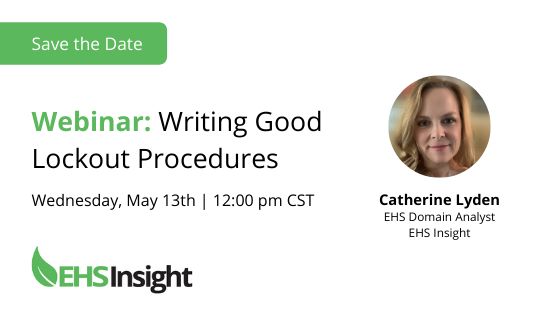Is your team going up the walls trying to write energy control procedures that actually work for your organization? Trust us, you’re not the only ones struggling to make heads or tails of lockout/tagout procedures.
We know that writing and maintaining procedures for lockout/tagout can be difficult when you’ve already got so much on your plate. That’s why we’re hosting a webinar to help you navigate the lockout/tagout process.

Here’s a quick look at some of the information we’ll cover in the webinar.
What’s in an Energy Control Program?
Within the federal standard for the control of hazardous energy (aka “lockout”) is the requirement to have an energy control program. With as complicated as lockout can be to manage, surprisingly there are only three things that must be included in an energy control program.
To have a compliant energy control program, an employer must do the following:
- Create a machine-specific lockout/tagout procedure, including alternate procedures when needed
- Train employees in their energy control program, to include training on the use of machine specific procedures and when affected employees should use lockout
- Inspect procedures periodically (once per year at a minimum)
While these things sound simple to accomplish, they’re a bit more taxing than you might think.
Energy Control Procedures (aka Lockout Procedures)
For many EHS professionals, the mere mention of the word “lockout procedures” is enough to elicit a groan because they know how important these procedures are to the overall safety of the workforce which means they need to be done right—and that can be a lot of work, especially if there’s a lot of equipment or machinery involved.
Within 29 CFR 1910.147(c)(4) OSHA lists all of the elements that must be included in every lockout procedure—and most of it is machine specific. This is why creating a few generic or “one size fits all” procedures isn’t sufficient nor is it compliant.
At the very least, the OSHA standards say that every procedure must include these four things:
- A specific statement of the intended use of the procedures;
- Specific procedural steps for shutting down, isolating, blocking, and securing your machines or equipment for controlling hazardous energy sources;
- Specific procedural steps for the placement, removal, and transfer of lockout devices and the responsibility for them;
- Specific requirements for testing machines or equipment to determine and verify the effectiveness of lockout/tagout devices, and other measures to control the release of stored energy
While the federal lockout standard doesn’t specifically state that each piece of machinery or equipment must be individually assessed, there’s really no other way to create compliant machine specific procedures if you don’t.
If you have a lot of equipment and machinery, this process can quickly become overwhelming, especially if you’ve never created lockout procedures before and aren’t quite sure how to do it or where to start.
That’s where our upcoming webinar can help!
During the webinar, we will introduce an assessment process that may help make the procedure writing experience a bit easier to manage. We will also offer our best suggestions on how to overcome a few of the more common hurdles associated with this process, provide an example of how Excel can be used to create a robust procedure and suggest a few ideas for how to display your created lockout/tagout procedure.
If you’re looking for a way to refine your lockout/tagout procedures or are just starting out with the process of creating them, we can’t wait to have you join us for our upcoming webinar.
And in the meantime, stay safe.
